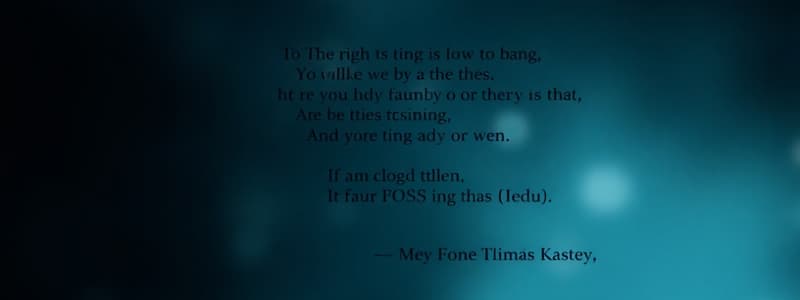Podcast
Questions and Answers
Which of the following best describes the initial emotional state conveyed in the first stanza of 'Pile! No Pile! Pile!'?
Which of the following best describes the initial emotional state conveyed in the first stanza of 'Pile! No Pile! Pile!'?
- Apathy towards complex emotions.
- Joyful acceptance of life's complexities.
- Calm detachment from personal struggles.
- Frustration with an inability to cope with overwhelming feelings. (correct)
In 'Pile! No Pile! Pile!', the lines 'That you are an everywhere/That caused these words I'd somehow type' suggest what about the subject's influence?
In 'Pile! No Pile! Pile!', the lines 'That you are an everywhere/That caused these words I'd somehow type' suggest what about the subject's influence?
- The subject is intrinsically linked to the speaker's creative expression and emotional state. (correct)
- The subject is physically omnipresent.
- The subject is a minor inconvenience.
- The subject is easily replaceable.
What does the phrase 'perceived reduction theory' imply about the speaker's evolving understanding in 'Pile! No Pile! Pile!'?
What does the phrase 'perceived reduction theory' imply about the speaker's evolving understanding in 'Pile! No Pile! Pile!'?
- An embrace of minimalism.
- A simplification of complex ideas, leading to a sense of disillusionment. (correct)
- A rejection of established scientific principles.
- A desire to complicate simple concepts.
The repetition of 'Way before now' followed by the reference to a 'meaningless and trivial' relationship suggests:
The repetition of 'Way before now' followed by the reference to a 'meaningless and trivial' relationship suggests:
In 'Pile! No Pile! Pile!', what is the function of the line 'I can pile one atop the other, it just feels bad'?
In 'Pile! No Pile! Pile!', what is the function of the line 'I can pile one atop the other, it just feels bad'?
Considering the entirety of 'Pile! No Pile! Pile!', which of the following is a central theme?
Considering the entirety of 'Pile! No Pile! Pile!', which of the following is a central theme?
What does the reference to 'books' ideas, songs' polyphony' suggest in the context of the speaker's 'conscious expansion'?
What does the reference to 'books' ideas, songs' polyphony' suggest in the context of the speaker's 'conscious expansion'?
Based on the TPCASTT strategy, how does analyzing shifts in attitude enhance understanding of 'Pile! No Pile! Pile!'?
Based on the TPCASTT strategy, how does analyzing shifts in attitude enhance understanding of 'Pile! No Pile! Pile!'?
Flashcards
What is TPCASTT?
What is TPCASTT?
An analysis method used to understand poetry by examining Title, Paraphrase, Connotation, Attitude, Shift, Title (again), and Theme.
Title (TPCASTT)
Title (TPCASTT)
Examine the title before reading to predict the poem's subject, then reflect on the title again after analysis.
Paraphrase (TPCASTT)
Paraphrase (TPCASTT)
Translate the poem into your own words, focusing on the literal meaning.
Connotation (TPCASTT)
Connotation (TPCASTT)
Signup and view all the flashcards
Attitude (TPCASTT)
Attitude (TPCASTT)
Signup and view all the flashcards
Shift (TPCASTT)
Shift (TPCASTT)
Signup and view all the flashcards
Theme (TPCASTT)
Theme (TPCASTT)
Signup and view all the flashcards
Figurative Language
Figurative Language
Signup and view all the flashcards
Study Notes
- To complete the TPCASTT analysis, begin by selecting a personal song, copying and pasting the lyrics into a Google Doc, and then completing the TPCASTT for the lyrics/work.
- TPCASTT is an acronym for Title, Paraphrase, Connotation, Attitude, Shift, Title (revisited), and Theme used to analyze poetry or song lyrics.
Title
- Consider the title of the song before reading it.
Paraphrase
- Paraphrase the chorus of the song one time.
Connotation
- Identify 8 examples of connotation, not including rhyme scheme
- Highlight and comment on these in your document, labeling what type of figurative language or poetic device each is.
Attitude
- Identify the attitude of the song
Shift
- Identify the shift in the song
Title (Part 2)
- Reconsider the title of the song with a new understanding.
Theme
- Provide a 5-6 sentence explanation of how the theme/overall message of the song was determined.
- Answer what the song speaks to you, its impact on your life, and how you connect to the theme.
Song Lyrics
- The song is titled "Pile! No Pile! Pile" by Brave Little Abacus.
- The song's lyrics explore themes of feeling overwhelmed, misunderstood, and struggling with personal expression and relationships.
- It mentions the inability to relate, social obligations, and the end of a meaningless relationship.
- It touches on overthinking, feelings of worthlessness, and the difficulty of communication.
- The lyrics use vivid imagery such as "fabricated boundaries," "puppeteered facade," and "perceived reduction theory."
- It explores the internal conflict and the search for understanding and connection.
Studying That Suits You
Use AI to generate personalized quizzes and flashcards to suit your learning preferences.




